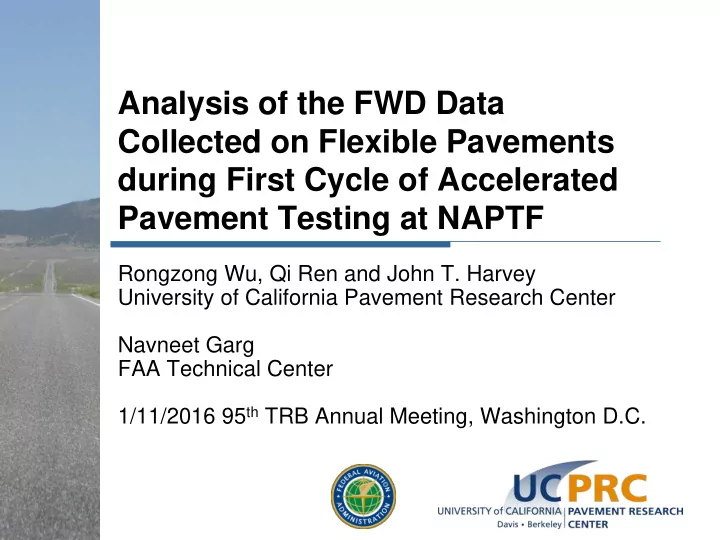

Analysis of the FWD Data Collected on Flexible Pavements during First Cycle of Accelerated Pavement Testing at NAPTF Rongzong Wu, Qi Ren and John T. Harvey University of California Pavement Research Center Navneet Garg FAA Technical Center 1/11/2016 95 th TRB Annual Meeting, Washington D.C.
Outline Background FWD Testing Procedure and Schedule Back-Calculation Method Results and Discussions Summary and Conclusions
Background – The Facility The Test Vehicle
Background - Layout and Cross Section 0.5 LFS LFC MFC MFS HFS HFC 0 HMA HMA HMA HMA HMA HMA HMA HMA HMA HMA HMA HMA HMA HMA HMA HMA HMA HMA Crushed Stone Base Crushed Stone Base Crushed Stone Base Crushed Stone Base Crushed Stone Base Crushed Stone Base Crushed Stone Base Crushed Stone Base -0.5 Crushed Quarry Screenings Crushed Quarry Screenings Crushed Stone Base Crushed Stone Base Crushed Quarry Screenings Crushed Quarry Screenings -1 -1.5 High Strength Subgrade High Strength Subgrade High Strength Subgrade High Strength Subgrade Medium Strength Subgrade Medium Strength Subgrade Medium Strength Subgrade Medium Strength Subgrade -2 Low Strength Subgrade (CS&S) Low Strength Subgrade (CS&S) Low Strength Subgrade (CS&S) Low Strength Subgrade (CS&S) -2.5 -3 -3.5 -4 0 50 100 150 200 250 300
Background – Traffic Program Six-wheel gear for the north half Four-wheel gear for the south half Wheel load history 45 kips (200kN) for 20,000 passes 65 kips (289kN) for the next 30,000 passes
FWD Testing – Schedule and Layout Uniformity Tests 10 ft x 10 ft grid 8 months before trafficking Routine Tests Three lines: North and south wheelpaths Centerline of the test track Every now and then during trafficking
FWD Testing Lines LANE 1 North Half LANE 2 LANE 3 C/L LANE 4 LANE 5 South Half LANE 6
FWD Back-calculation Procedure Three layer system Combine HMA layer Combine AB and ASB layer Bedrock below thick subgrade except for two layer pavements Multi-layer elastic theory Kalman Filter based search algorithm Matching measured deflections by adjusting layer stiffness
Results and Discussions Overall layer stiffness shortly after construction Effect of Temperature and Age on HMA stiffness Comparison of back-calculated and estimated stiffness master curves Effect of traffic on stiffness HMA layer Base layer Bas + subbase combined layer Subgrade
Overall Layer Stiffness – Chart
Overall Layer Stiffness - Numbers Test Item P-209: Crushed P-401: HMA AB + ASB Subgrade ID Stone Base LFS 4,326 (0.11) 219 (0.12) 50 (0.12) LFC 4,558 (0.18) 176 (0.12) 52 (0.11) MFC 3,783 (0.14) 161 (0.10) 93 (0.05) MFS 3,166 (0.19) 584 (0.25) 106 (0.04) HFC 4,683 (0.18) 182 (0.26) 179 (0.09) HFS 4,759 (0.20) 215 (0.11)
Effect of Temperature and Aging on HMA Stiffness – LFS
Effect of Temperature and Aging on HMA Stiffness – LFS
Comparison of Stiffness Master Curves
Effect of Traffic on HMA Stiffness - LFS
Effect of Traffic on HMA Stiffness - LFC
Effect of Traffic on Base Stiffness - LFS
Effect of Traffic on Base + Subbase Stiffness - LFC
Effect of Traffic on Subgrade Stiffness - LFC
Observations Subgrade stiffnesses are strongly correlated to CBR values. Aging did occur in the first year but very little afterwards Temperature effect on HMA stiffness can be predicted from mix design data Effect of APT trafficking Softening for HMA, crushed stone base, crushed stone base and aggregate subbase combined layer. Stiffening for low strength subgrade
Recommendations FWD data needs to be extensive to allow trend identification May need to account for material deterioration or strengthening when predicting pavement performance Temperature effect of HMA can be estimated from mix design
Questions ?
Moisture Sensors in LFC Cross Section for CC1_LFC_S along Traffic Direction 500 0 HMA Crushed Stone Base -500 Crushed Quarry Screenings -1000 -1500 Depth (mm) -2000 Low Strength Subgrade (CS&S) -2500 -3000 -3500 -4000 7 6.5 7.5 8 8.5 9 9.5 10 4 Horizontal Distance (mm)
All Moisture Readings Moisture Sensor Readings at Different Depth for LFC S 2.35 Z=1301 2.3 Z=2336 Z=3352 2.25 2.2 Moisture Content 2.15 2.1 2.05 2 1.95 1.9 Q2-99 Q3-99 Q4-99 Q1-00 Q2-00 Q3-00 Q4-00 Q1-01 Q2-01 Q3-01 Q4-01 Q1-02 Q2-02 Q3-02 Reading Time
Subgrade Moisture Content Change While Trafficking - LFC Moisture Sensor Readings at Different Depth for LFC 2.35 2.3 2.25 2.2 Moisture Content 2.15 2.1 2.05 2 Z=1301 Z=2336 1.95 Z=3352 1.9 4 0 1 2 3 5 6 10 4 Repetition
Recommend
More recommend